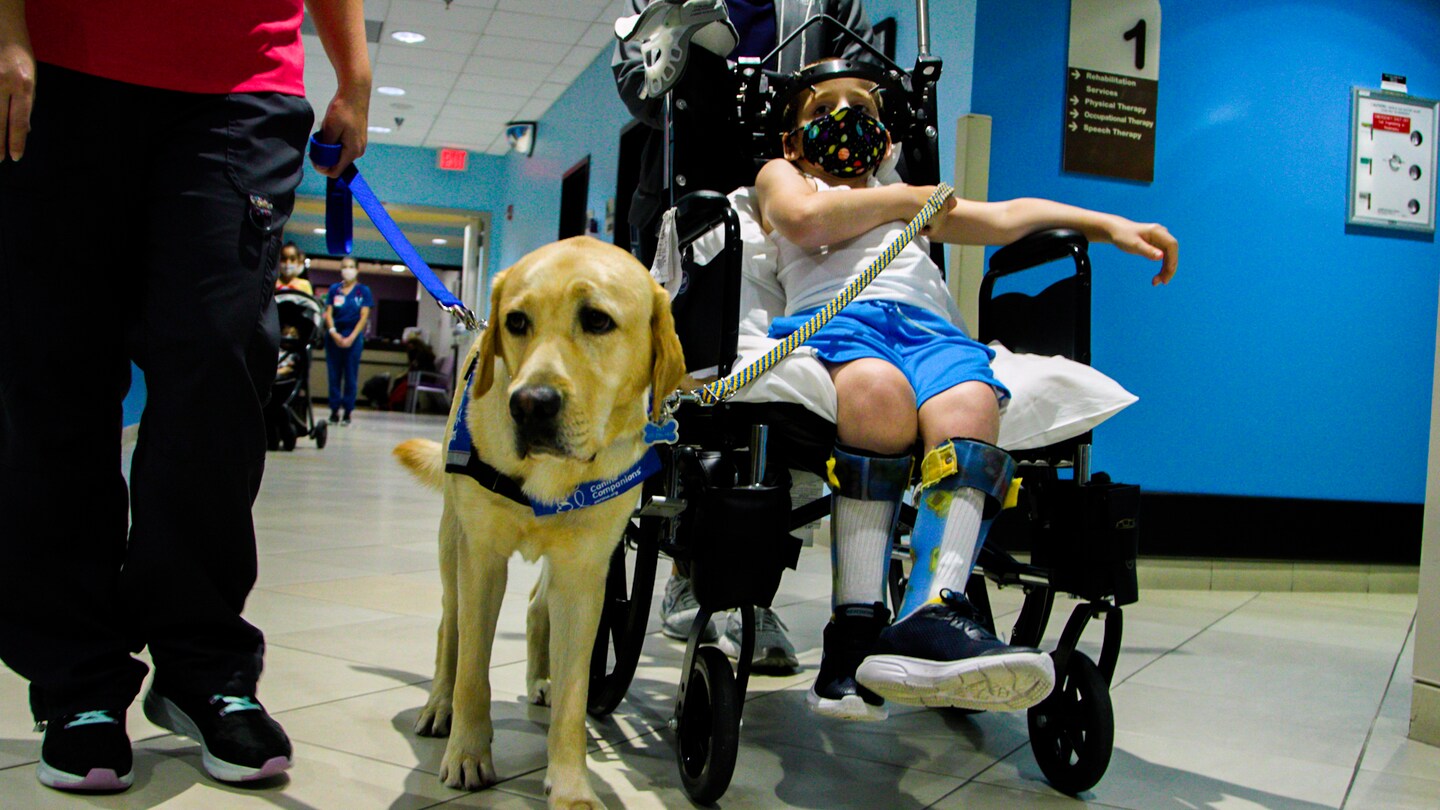

He can also play cards (using his mouth) as directed by his handler. He doesn’t know which cards to play on his own, but he has the dexterity to gingerly take a single playing card from someone’s hand and give it to the other player. Parks also barks on command and offers tactile stimulation, like lying across a child’s body when told to do so.
He comforts chronically ill children by cuddling with them and also motivates them to take walks around the hospital.
Kim Burbage — a child-life specialist at the hospital who works with Parks and cares for him outside of their day jobs — said dogs are invaluable in a hospital setting.
“He is definitely a huge part of our team,” she said.
Burbage, who has worked at the hospital for 15 years, said hiring a facility dog was something her department has wanted for years.
“We started developing the position and the policies surrounding it in the fall of 2020,” she said.
The hospital applied to receive an animal from Canine Companions, a nonprofit that provides trained service dogs to individuals and organizations that focus on health care, criminal justice or education.
The expertly skilled animals — which cost about $50,000 to train — are free to qualified applicants. Last year, Canine Companions placed 373 service dogs, and since its founding in 1975, it has matched more than 7,100 canines with worthy companions.
“We rely on the generosity of individual donors and foundations and special events,” explained Martha Johnson, a public relations and marketing coordinator at Canine Companions. In Parks’s case, the Arnold & Winnie Palmer Foundation contributed a grant to fund his placement at the hospital.
Canine Companions rears the service dogs in Northern California, and crossbreeds Labradors and golden retrievers “so we get the best of the best” in terms of work ethic and temperament, Johnson said.
Once the puppies are 8 weeks old, they are flown to volunteer puppy raisers, who teach them socialization skills and basic commands for a little more than a year. The dogs then return to one of six Canine Companions training centers for up to nine months, when they are placed with a handler following a two-week matching program.
Only 55 percent of the dogs are ultimately placed, Johnson explained, “because our standards are so high.” Dogs that do not make the cut as a service animal sometimes return to their puppy raisers, or they are sent to other programs, such as search-and-rescue organizations, where they are better suited.
Burbage — whose role at the hospital has recently expanded to include dog handler responsibilities — visited the Orlando center to find the perfect pooch to join the staff.
Her goal, she said, was to find a dog that could serve as a “therapeutic tool” to help children and adolescents cope with difficult diagnoses. She looked for an animal that was equal parts playful and attentive, while still maintaining a sense of calm when necessary.
She connected with numerous dogs at the center, but “Parks was the best fit for her,” said Robyn Bush, a trainer at Canine Companions. “He stood out as the one that was working really flawlessly with her.”
Bush teaches the dogs to hone advanced skills and complicated commands.
“There’s a lot they learn,” said Bush, adding that “you can use the commands in a variety of ways.”
Burbage felt a close connection to Parks, saying she was amazed by his obedience and intellect, and also tickled by his “goofy side,” which she knew would bode well for patients in need of a pick-me-up.
“He is really wonderful,” she said.
Since February, Parks — whose onboarding costs were paid by PetSmart Charities and the Orlando Health Foundation — has been working full time, Monday through Friday, at the hospital. He attends individual sessions with patients, always with Burbage.
Parks provides the kids with kisses and cuddles, and has also learned how to walk properly next to wheelchairs and other assistive devices. He has been trained to cater to the specific medical, physical and emotional needs of each child with whom he interacts.
For instance, many patients with autism or sensory integration disorder respond well to deep pressure. Using a command called “cover,” Parks is trained to sprawl out on top of a patient, serving as a weighted blanket.
There have been several instances in which Parks has helped hospital staff better understand how a child is progressing medically, Burbage said. The dog’s presence can encourage a patient to open up and engage in ways they otherwise wouldn’t.
“They just get so excited to have him there,” Burbage said.
Although Parks already knows an impressive repertoire of tricks, he is learning how to use his snout to push a plastic bowling ball, which is an activity Burbage hopes he can play with the children in the near future. He is continually learning new commands and building on the ones he has already mastered.
“When he is working, he tends to be a little bit more serious, having to focus on all the commands,” Burbage said. “I can’t wait to see where he’s at in a couple months.”
In his short time at the hospital, she added, he has already left an indelible impression on many patients and their families.
“I love when he’s around,” said Makiyah, a patient at the hospital who for privacy reasons asked to use only her first name. “He’s a nice puppy.”
Facility dogs, in general, “have a very strong impact day to day, but also a lifelong impact on patients,” said Bush of Canine Companions, which offers ongoing support to the animals it trains. “It’s wonderful to see them touch so many lives.”